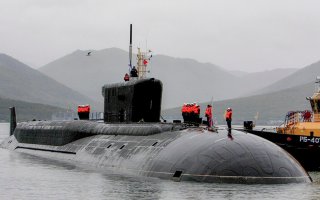Russia’s New State-of-the-Art Ballistic Missile Submarine Will Soon Head to Sea
The submarine was developed by the Rubin Design Bureau and was laid down in July 2014, but the construction of it was delayed due to supply problems.
Delays are increasingly common with military hardware today, and when it comes to Russia it is almost expected that deadlines won’t be met. This has certainly been the case with Knyaz Oleg, the latest improved Borei-class (Project 955A) nuclear-powered ballistic missile submarine.
The submarine was developed by the Rubin Design Bureau and was laid down in July 2014, but the construction of it was delayed due to supply problems. The boat was only finally launched last summer and is now about to begin sea trials early next month.
“Under the plans as of today, the Knyaz Oleg will deploy to the sea for trials for the first time at the beginning of June,” a source in the domestic defense industry told Tass.
It had been planned that the submarine would enter service by Russia’s Navy Day, which is a senior holiday of the Russian Armed Forces and celebrated annually on the last Sunday of July. The day honors the sailors in units of the Russian Navy and was regularly held during the Soviet era until 1980. However, it was reestablished by the Decree of the Russian president Vladimir Putin in 2017.
Given that the Knyaz Oleg will need to complete a program of shipbuilders’ sea and state trials it is unlikely the submarine will meet the deadline. The sea and state trials notably include a test-launch of the Bulava intercontinental ballistic missile (ICBMs) from the Barents Sea from a submerged position against a target at the Kura proving ground on the Kamchatka Peninsula in the Russian Far East.
Russia’s Navy Commander-in-Chief Admiral Nikolai Yevmenov earlier told the Defense Ministry’s Krasnaya Zvezda newspaper that the Navy would receive the Borei-A-class strategic nuclear-powered missile-carrying submarine Knyaz Oleg by the end of 2021.
Knyaz Oleg isn’t the first of the submarines to see such a delay in entering service. After eight years in construction, the first Borei-A-class submarine Knyaz Vladimir was commissioned during a flag-raising ceremony last summer and was handed off to the Russian Navy’s Northern Fleet. Named for Prince Vladimir the Great of Novgorod and ruler of the Kievan Rus from the late tenth and early eleventh centuries, Knyaz Vladimir was the first of the advanced iteration of the Borei-class Project 955A. The strategic missile-carrying underwater cruiser represents the fourth generation of nuclear-powered subs built for the Russian Navy.
The Russian Navy currently operates four Project 955/Project 955A strategic missile-carrying submarines, and three additional Project 955A submarines are now in various stages of their respective construction at the Sevmash Shipyard. Each of the Project 955/Project 955A submarines carries sixteen Bulava ICBMs. As with the nuclear-powered ballistic missile submarines operated by the United States, China, France, the United Kingdom and India, the primary purpose of the Borei-class is to bring ruin to an adversary’s cities, even if other nuclear forces are whipped out in a first strike.
Peter Suciu is a Michigan-based writer who has contributed to more than four dozen magazines, newspapers and websites. He regularly writes about military small arms, and is the author of several books on military headgear including A Gallery of Military Headdress, which is available on Amazon.com.
Image: Reuters

